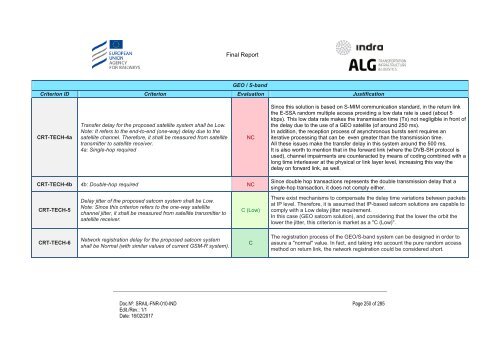Study on feasibility of SATCOM for railway communication
SRAIL-FNR-010-IND%20-%20FinalReport_v1.1_20170216
SRAIL-FNR-010-IND%20-%20FinalReport_v1.1_20170216
You also want an ePaper? Increase the reach of your titles
YUMPU automatically turns print PDFs into web optimized ePapers that Google loves.
Final Report<br />
GEO / S-band<br />
Criteri<strong>on</strong> ID Criteri<strong>on</strong> Evaluati<strong>on</strong> Justificati<strong>on</strong><br />
CRT-TECH-4a<br />
Transfer delay <strong>for</strong> the proposed satellite system shall be Low.<br />
Note: It refers to the end-to-end (<strong>on</strong>e-way) delay due to the<br />
satellite channel. There<strong>for</strong>e, it shall be measured from satellite<br />
transmitter to satellite receiver.<br />
4a: Single-hop required<br />
NC<br />
Since this soluti<strong>on</strong> is based <strong>on</strong> S-MIM communicati<strong>on</strong> standard, in the return link<br />
the E-SSA random multiple access providing a low data rate is used (about 5<br />
kbps). This low data rate makes the transmissi<strong>on</strong> time (Tx) not negligible in fr<strong>on</strong>t <strong>of</strong><br />
the delay due to the use <strong>of</strong> a GEO satellite (<strong>of</strong> around 250 ms).<br />
In additi<strong>on</strong>, the recepti<strong>on</strong> process <strong>of</strong> asynchr<strong>on</strong>ous bursts sent requires an<br />
iterative processing that can be even greater than the transmissi<strong>on</strong> time.<br />
All these issues make the transfer delay in this system around the 500 ms.<br />
It is also worth to menti<strong>on</strong> that in the <strong>for</strong>ward link (where the DVB-SH protocol is<br />
used), channel impairments are counteracted by means <strong>of</strong> coding combined with a<br />
l<strong>on</strong>g time interleaver at the physical or link layer level, increasing this way the<br />
delay <strong>on</strong> <strong>for</strong>ward link, as well.<br />
CRT-TECH-4b 4b: Double-hop required NC<br />
CRT-TECH-5<br />
Delay jitter <strong>of</strong> the proposed satcom system shall be Low.<br />
Note: Since this criteri<strong>on</strong> refers to the <strong>on</strong>e-way satellite<br />
channel jitter, it shall be measured from satellite transmitter to<br />
satellite receiver.<br />
C (Low)<br />
Since double hop transacti<strong>on</strong>s represents the double transmissi<strong>on</strong> delay that a<br />
single-hop transacti<strong>on</strong>, it does not comply either.<br />
There exist mechanisms to compensate the delay time variati<strong>on</strong>s between packets<br />
at IP level. There<strong>for</strong>e, it is assumed that IP-based satcom soluti<strong>on</strong>s are capable to<br />
comply with a Low delay jitter requirement.<br />
In this case (GEO satcom soluti<strong>on</strong>), and c<strong>on</strong>sidering that the lower the orbit the<br />
lower the jitter, this criteri<strong>on</strong> is market as a "C (Low)".<br />
CRT-TECH-6<br />
Network registrati<strong>on</strong> delay <strong>for</strong> the proposed satcom system<br />
shall be Normal (with similar values <strong>of</strong> current GSM-R system).<br />
C<br />
The registrati<strong>on</strong> process <strong>of</strong> the GEO/S-band system can be designed in order to<br />
assure a "normal" value. In fact, and taking into account the pure random access<br />
method <strong>on</strong> return link, the network registrati<strong>on</strong> could be c<strong>on</strong>sidered short.<br />
Doc.Nº: SRAIL-FNR-010-IND<br />
Edit./Rev.: 1/1<br />
Date: 16/02/2017<br />
Page 250 <strong>of</strong> 285


